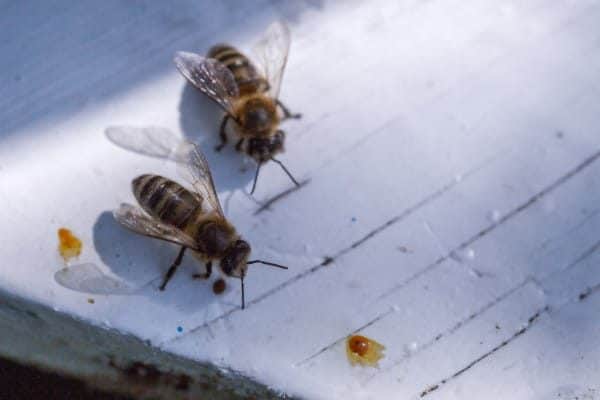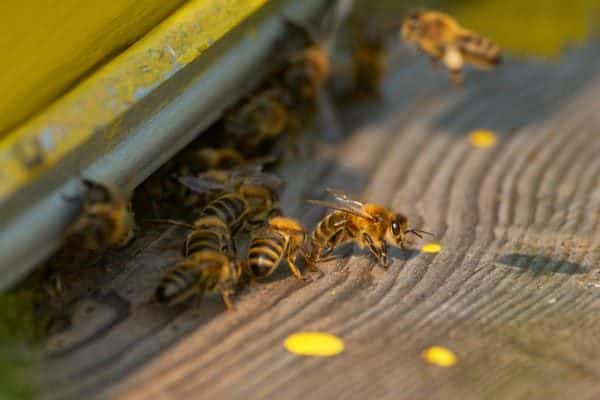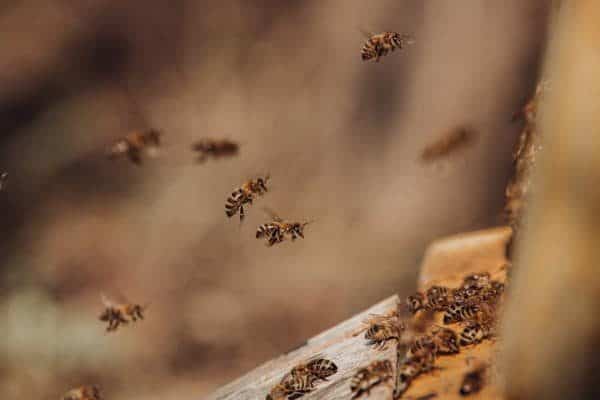There is a common saying “Everything that eats, excretes” (poops). When it comes to this natural law, Bees are no exception. These creatures are extraordinarily fastidious about cleaning and hygiene within their hives.

A bee will literally remove itself from the hive to go die outside just to avoid contaminating the hive. The worker bees will be constantly cleaning and maintaining the cleanliness of the hive. You probably have wondered and asked whether bees poop and/or where they do their business.
Do Bees Poop? Yes, bees poop, like humans, bees need to poop too. Their digestive system consists of three parts, the foregut, midgut and hindgut. The hindgut connects to the rectum where 90% of remaining water is absorbed before the poop is expelled. Bees poop while flying, not in their hive and they can hold the poop in for months when it’s too cold to fly outside the hive.
Stay with me as we unravel and delve into the outhouse bee mysteries and behavior.
To help us better understand how the bee handles its food through its digestive system, let’s take a cursory glance at the description of a bee’s digestive system anatomy. What this will do is give us a good idea of how bees digest food, make poop, and other waste.
Bee digestive system
The bee’s digestive system consists of three main sections, the foregut, the midgut, and the hindgut.
The foregut and hindgut are lined with cuticle, the same material that lines the outside of the bee’s body. In practical terms, this means that the foregut and hindgut are not sites for nutrient absorption within the bee. This is because the nutrients cannot traverse or pass through the cuticular lining of either section.
The midgut, in contrast, is not lined with cuticle. This makes nutritional absorption the primary function.
The Foregut
The Foregut is composed of the mouth, esophagus, and crop. Food enters the digestive system through the mouth and travels down a tube (esophagus) that runs from the mouth, through the thorax, and into the crop in the abdomen.
The crop, or honey stomach as it is sometimes referred to by beekeepers, stores food and also serves as a storage place for nectar collected by bees from flowers for transfer to the hive.
It’s an initial site for the digestion of food in the bee and has the ability to greatly expand when it’s full of honey or nectar so-much-so that the abdomen swells.
The foregut and the midgut are separated by a special valve called proventriculus which is located at the end of the crop. This valve grinds and breaks down food particles (such as pollen) and will then filter pollen out of the crop contents. Food then passes through the proventricular valve and on into the bees mid-gut.
The Midgut
The midgut (ventriculus) is the primary site where enzymes digest food and absorption of nutrients takes place. It is not lined by cuticle but rather by the peritrophic membrane that allows the absorption of nutrients straight into the hemolymph (bee blood). This membrane likely protects the cells that line the internal surface of the midgut.
Interestingly, it is worth noting that because the midgut is somewhat permeable in order to enable its function as the site for nutrient absorption, this is where many viruses and other bee pathogens enter the hemolymph. This applies especially to the Nosema pathogens (N.apis and N ceranae) and some other viruses.
The Malpighian tubules occur at the end of the midgut and are essentially spaghetti like extensions of the tract that float freely in the bee’s body cavity. They act as the bee’s kidneys and extract waste products from the hemolymph and produce uric acid granules. They help with osmoregulation (water management) within the body of the bee.
The Hindgut
Do bees pee? In this part of our article, we will find the answer to this interesting question. In the hindgut or final section of the digestive system are the small intestines (ileum). This is a short tube that connects the midgut to the rectum.
The rectum absorbs water, salt, and other beneficial substances prior to waste excretion. There are small areas on the rectum called rectal pads.
These sections reabsorb more than 90% of water that was used by the Mapiglian tubules to collect waste.
This function is important because bees, like most insects, try to retain as much moisture as possible from the food they eat. Thus, after reabsorbing much of their water, they tend to defecate moderately dry poop and uric acid solids.
Uric acid is what bees excrete with their bee poop. They do not make liquid nitrogenous waste as in urine.
So bees don’t pee in the way we do all their waste including any uric acid is passed in their poop.
What Is In Bee Poop?
Honey bees stick to a main diet of nectar and honey for a carbohydrate source and pollen for a protein source. Interestingly, fiber is present in honey and pollen.
Shells of pollen grains can be found in bee poop. Fiber can also be found together with other undigested pollen grains such as pollen fat from flowers visited.
What Is Bee Poop Like?
Bee feces or frass, as it is sometimes referred to, is somewhat sticky and yellow. It’s quite hard to get off things. If you live close to a bee flight path that’s very busy from spring to summer, when bee numbers are at their greatest, you will see that bee droppings cover almost everything. Bees typically fly in set bee highways between hive and food source.

In these high traffic areas, you will see sticky yellow spots on cars and many other things. Sometimes when bees eat something that disagrees with them like overripe fruit, or they have a disease like Nosema, they might defecate inside the hive, which is not a good thing.
Cleansing Flights
Cleansing flights are simply a polite term for a defecating or pooping flight. In the winter, bees will be stuck in the hive for long stretches of time (days, weeks, or even months).
So where do they poop all that time? They will be holding it in! Then a warm day comes along, 10 °C (55°F), the magic temperature that triggers the bees to go outside and relieve themselves.

The bees rush outside to let it all out quickly. They need to be as quick as they can and they can’t go too far, possibly they fly 1000 feet away from the hives. Bees don’t fly at temperatures below 55°F because their wing muscles get stiff putting them at high risk of not being able to fly back to the hive. They end up dying outside in the snow.
How Often Does A Honey Bee Poop?
Weather permitting; bees will poop on foraging flights when nature calls. Biological functions are closely determined and dictated depending on weather conditions. Bees will defecate as often as they need to when the weather is warm.
The Queen is the only bee that poops inside the hive. The worker bees attend to her clean up and keep her well groomed. Other worker bees also tend to the larvae and drones.
When the weather gets too cold for bees to go outside on their “Cleansing flight”, a honeybee will hold for weeks before defecating. They will not willingly defecate inside the hive.
It’s interesting to note that “cleansing runs” also refer to when bees are doing normal hive cleaning. On a warm day (55°F) or more, they will also bring out other debris from inside the hive and drop it outside. This includes dead bees, dirt, or any other foreign objects.
Do Bees Poop Beeswax?
Beeswax is not bee poop. Beeswax is produced by young bees,10 to 20 days old after emerging from the comb cell. They have eight wax glands located inside of their fourth to seventh abdominal plates on the abdomen.
The wax glands are activated by the young bees gorging themselves on honey to produce tiny flakes of wax that they then chew and shape into comb cells.
Do Bees Poop Honey ?
Bees don’t poop honey. Honey is the final product of flower nectar after being processed by Honey bees through the addition and reaction of enzymes and then dehydration of the nectar to bring down moisture to 20%. The honey is then stored in cells of their wax combs.
Do Honey Bees Fart?
In the real sense, as we humans fart, bees most probably don’t fart. Farts are the result of bacterial action on plant and meat digestion that result in the production of methane gas in the digestive tract.
Honey bees stick to a diet of nectar and honey for carbohydrates and pollen for a protein source. Expert opinions differ on whether bees do in fact fart.
One school of thought suggests the fiber found in pollen and honey traps air bubbles as it moves through the bees digestive system that, when released, can come out as a fart. Other experts have doubts about this theory, arguing that a honey bee does not breathe through its mouth or nose.
Bee Poop On Laundry? How To Remove It
Bee poop is typically very difficult to remove from laundry, even experts will agree. The stains might well be pollen stains from all the pollen a bee would be carrying back to the hive. And bee poop does contain a minute amount of propolis, which is very strong bee glue! Some ideas that have proven helpful in removing bee poop from laundry include;
- Isopropyl alcohol can help in removing bee poop from laundry. Try the highest percentage you can find. Soak and scrub the stained area with the alcohol and then wash the item the normal way.
- Nail Polish remover also helps in the removal of bee poop from clothes. That’s because it consists of acetone, a highly flammable liquid. So use with caution. It does appear to do a fine job. Ethanol also works just as well.
The Wrap Up
It is a wonder of nature how long bees can hold their poop in an effort to keep their hive clean. Weeks, months. They patiently wait for warm weather making it safe to dash out on a short cleansing flight to relieve themselves. The end result is a very sticky, yellow substance that is incredibly hard to clean off the surface it lands on.
No dead bees on the ground, sticky yellow poo spots on cars and laundry is a reminder that the bees are well and alive, and holding on waiting for spring to come around.
Considering how many bees live in such a small space as a beehive, the result of worker bees tireless efforts is an amazingly clean area.
References
https://jeb.biologists.org/content/29/2/310
The Internal Anatomy of the Honey Bee
Now speak the truth: is honey actually poop or vomit?
https://beekeepingcoach.com/is-honey-bee-poop/
